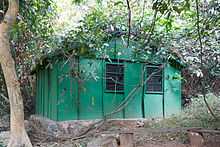Gombe Chimpanzee War
| Gombe Chimpanzee War | |||||||
|---|---|---|---|---|---|---|---|
| |||||||
| Belligerents | |||||||
| Kahama chimpanzees | Kasakela chimpanzees | ||||||
| Strength | |||||||
| 7 males, 3 females | 8 males, 12 females | ||||||
| Casualties and losses | |||||||
| 10 chimpanzees | 1 chimpanzee | ||||||
 Location within Africa | |||||||
The Gombe Chimpanzee War (also known as the "Four-Year War" of Gombe), lasting from 1974 to 1978, was a violent conflict between two communities of chimpanzees in Gombe Stream National Park, in Tanzania. The belligerent groups were the Kasakela and the Kahama, which occupied territories in the northern and southern areas of the park, respectively.[1] The two had previously been a single, unified community, but by 1974 researcher Jane Goodall, who had been observing the community, first noticed the chimps dividing themselves into northern and southern sub-groups.[2] Later computer-aided analysis of Goodall's notes would reveal that the social rift between the two groups had been present as early as 1971.[3]
The Kahama group, in the south, consisted of six adult males (among them the chimpanzees known to Goodall as "Hugh", "Charlie", and "Goliath"), three adult females and their young, and an adolescent male (known as "Sniff").[2] The larger Kasakela group, meanwhile, consisted of twelve adult females and their young, and eight adult males.[2]
The war
The first outbreak of violence occurred on January 7, 1974,[4] when a party of six adult Kasakela males attacked and killed "Godi", a young Kahama male, who had been feeding in a tree.[1] This was the first time that any of the chimpanzees had been seen to deliberately kill a fellow chimp.[4]
Over the next four years, all six of the adult male members of the Kahama were killed by the Kasakela males.[5] Of the females from Kahama, one was killed, two went missing, and three were beaten and kidnapped by the Kasakela males.[5] The Kasakela then succeeded in taking over the Kahama's former territory.[5]
These territorial gains were not permanent, however; with the Kahama gone, the Kasakela's territory now butted up directly against the territory of another chimpanzee community, called the Kalande.[6] Cowed by the superior strength and numbers of the Kalande, as well as a few violent skirmishes along their border, the Kasakela quickly gave up much of their new territory.[6]
Effects on Goodall
The outbreak of the war came as a disturbing shock to Goodall, who had previously considered chimpanzees to be, although similar to human beings, "rather 'nicer'" in their behavior.[7] Coupled with the observation in 1975 of cannibalistic infanticide by a high-ranking female in the community, the violence of the Gombe war first revealed to Goodall the "dark side" of chimpanzee behavior.[7] She was profoundly disturbed by this revelation; in her memoir Through a Window: My Thirty Years with the Chimpanzees of Gombe, she wrote:
For several years I struggled to come to terms with this new knowledge. Often when I woke in the night, horrific pictures sprang unbidden to my mind—Satan [one of the apes], cupping his hand below Sniff's chin to drink the blood that welled from a great wound on his face; old Rodolf, usually so benign, standing upright to hurl a four-pound rock at Godi's prostrate body; Jomeo tearing a strip of skin from Dé's thigh; Figan, charging and hitting, again and again, the stricken, quivering body of Goliath, one of his childhood heroes. ...[8]
Legacy

When Goodall reported on the events of the Gombe War, her account of a naturally-occurring war between chimpanzees was not universally believed. At the time, scientific models of human and animal behavior virtually never overlapped.[9] Some scientists accused her of excessive anthropomorphism;[9] others suggested that her presence, and her practice of feeding the chimpanzees, had created violent conflict in a naturally peaceful society.[10] However, later research using less intrusive methods confirmed that chimpanzee societies in their natural state do go to war.[10][11]
References
- ↑ 1.0 1.1 Goodall 2010, p. 121
- ↑ 2.0 2.1 2.2 Goodall 2010, p. 120
- ↑ Barras, Colin (7 May 2014). "Only known chimp war reveals how societies splinter". New Scientist. Retrieved 11 June 2014.
- ↑ 4.0 4.1 Morris, p. 288
- ↑ 5.0 5.1 5.2 Morris, p. 289
- ↑ 6.0 6.1 Goodall 2010, pp. 129–130
- ↑ 7.0 7.1 Goodall 2010, p. 128
- ↑ Goodall 2010, pp. 128–129
- ↑ 9.0 9.1 Bradshaw, G. A. (2009). Elephants on the Edge: What Animals Teach Us about Humanity. Yale University Press. p. 40. ISBN 9780300154917.
- ↑ 10.0 10.1 Morris, p. 290
- ↑ http://www.sciencedaily.com/releases/2014/09/140917131816.htm
Bibliography
- Goodall, Jane (2010). Through a Window: My Thirty Years with the Chimpanzees of Gombe. Houghton Mifflin Harcourt. ISBN 9780547488387.
- Morris, Ian (2014). War! What Is It Good For?: The Role of Conflict and the Progress of Civilisation from Primates to Robots. MacMillan. ISBN 9781847654540.
Further Reading
- Goodall, Jane (1986). The chimpanzees of Gombe: patterns of behavior. Belknap Press of Harvard University Press. ISBN 9780674116498.